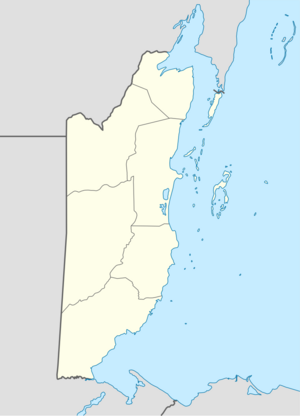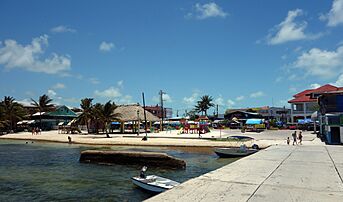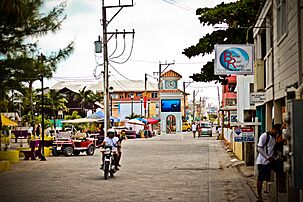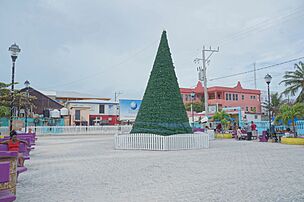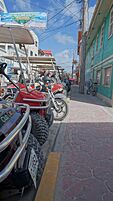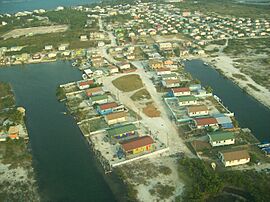San Pedro Town facts for kids
Quick facts for kids
San Pedro Town
|
|
|---|---|
| Town of San Pedro, Ambergris Caye | |
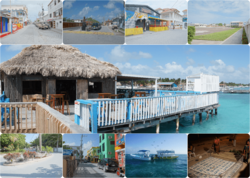
San Pedro Collage
|
|
| Nickname(s):
La Isla Bonita
|
|
| Country | Belize |
| District | Belize |
| Constituency | Belize Rural South |
| San Pedro | 1848 |
| Area | |
| • Total | 71 km2 (27.5 sq mi) |
| Elevation | 2 m (7 ft) |
| Population
(2010)
|
|
| • Total | 11,767 |
| • Estimate
(2016)
|
17,429 |
| • Density | 165.21/km2 (427.9/sq mi) |
| Demonym(s) | San Pedrano(a) |
| Time zone | UTC-6 (Central) |
| Climate | Aw |
San Pedro is a lively town located on the southern part of Ambergris Caye, a beautiful island in Belize, Central America. It's part of the Belize District. In 2015, about 16,444 people lived there. It is the second-largest town in the Belize District.
People from San Pedro are called San Pedranos. Many of them originally came from Mexico. Most San Pedranos speak both Spanish and English very well. Because of the local Kriol language, they also often speak a mix of English and Spanish called "Kitchen Spanish." It's often said that you're not a true San Pedrano unless you know how to fish!
The town is famous for being the inspiration behind Madonna's song "La Isla Bonita" (which means "The Beautiful Island"). The song starts with the line "last night I dreamt of San Pedro." Even though Madonna later said the name might have come from a road sign, the song has helped make San Pedro a popular place for tourists to visit.
Contents
History of San Pedro
The first people to settle permanently in San Pedro arrived between 1848 and 1849. These were often families of fishermen who had already built fishing camps on the island. They moved their families here for safety during a conflict called the "Guerra de Castas" in Mexico.
At first, there were only about four families. Soon, more families joined them from a nearby area called Bacalar. The small settlement quickly grew into a village with about 30 houses and over 50 people. These early settlers were farmers and fishers in Yucatán, and they continued these activities in San Pedro.
On November 27, 1984, San Pedro officially became a town. This was a big celebration for the community. Gilberto Chico Gomez became the town's first mayor.
San Pedro Gallery
Tourism and Nature
San Pedro has become a very popular place for tourists over the years. It has many protected natural areas. These include the Hol Chan Marine Reserve, Shark Ray Alley, and Bacalarchico.
One of San Pedro's most special features is the Belize Barrier Reef. This reef is the second-largest barrier reef in the world, after the Great Barrier Reef in Australia. It is home to many different kinds of sea creatures and plants.
A main industry in San Pedro is tourism, especially scuba diving. So many visitors come to dive that there are two special decompression chambers on the island. These chambers help divers if they have problems from going too deep.
The Ambergris Museum is also in the town. A long road in the north of the island has helped new resorts and beach houses grow, making it easier to explore than just by boat.
Today, San Pedro is well-known for its exciting festivals. One of the most famous is "El Gran Carnaval de San Pedro."
This Carnaval festival has been a tradition since the 1870s. It centers around a character called "Juan Carnaval." Legend says Juan was an island god with many wives and children. It is believed he was killed by a jealous wife. His will is traditionally read on Ash Wednesday. A doll-like figure of Juan Carnaval is burned each year. This burning symbolizes cleaning away the community's past mistakes.
The tradition started with people using powder. Now, it has grown to include water paint and breaking eggs. There are some rules for the festival:
- The first day is only for children until 7 PM.
- Painting is allowed from Ruby's Hotel beachfront to the cemetery and Barrier Reef Drive.
- Participants are not allowed to paint people who are not joining in.
- They cannot paint public signs, buildings, or the "Comparsa" dancers.
- It is forbidden to use rotten eggs, spray paint, or oil paints.
Sister Cities
San Pedro Town has a special connection with another city:
 Wilmington, North Carolina, United States (since 2007)
Wilmington, North Carolina, United States (since 2007)
See also
 In Spanish: San Pedro (Belice) para niños
In Spanish: San Pedro (Belice) para niños


